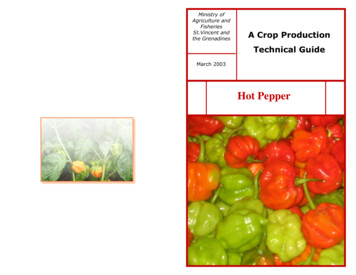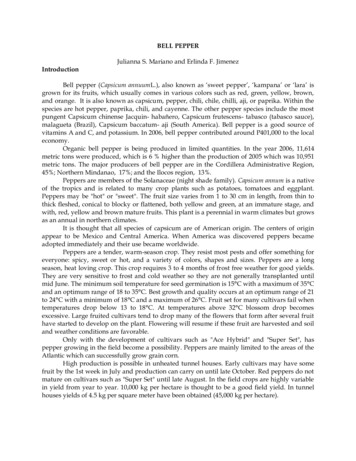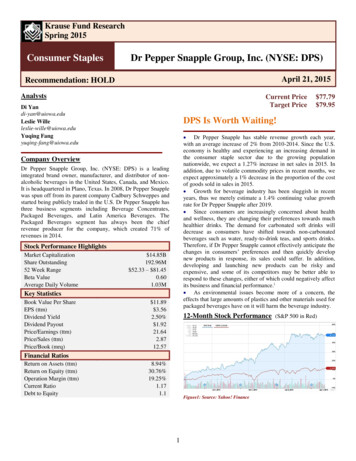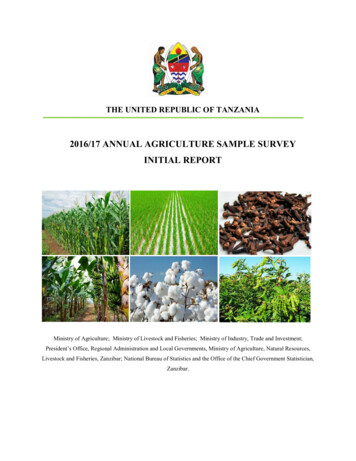
Transcription
Ministry ofAgriculture andFisheriesSt.Vincent andthe GrenadinesA Crop ProductionTechnical GuideMarch 2003Hot Pepper
Sponsor’s Page
A Crop ProductionTechnical GuideREFERENCESA Training Manual for the Production of Hot Peppers BELIZE.CARDI (Caribbean Agricultural Research and Development Institute) Technical Improvement File on Hot PeppersHERMAN, Adams et al. 1999.beanCelestial Arts, 1997.Hot Pepper Lines for the Carib-The Pepper Pantry: HerbanerosHot PepperMinistry of Agriculture and FisheriesSt.Vincent and the GrenadinesMarch 2003
This guide to production was compiled by a group oftechnical officers within the Department of Agriculture,the Caribbean Agricultural Research and DevelopmentInstitute (CARDI) and the St.Vincent MarketingCorporation (SVMC). Layout and designCommunications Unit.werealsodoneby rhizoctoniaBotrytis the FusariumYellow SigatokaScabSooty MouldSouthern BlightSeptoria Leaf spotMelanoseRustGummosisC H A R T The contents are a representation of different researchwork done on the production of this crop under similarconditions as exist in St.Vincent and the Grenadines.The graphical presentations and some of the photographsare also reproduction from various sources including theCommunications Unit in the Ministry of Agriculture andFisheries. U S EphytophthoraBlack pod Greasy SpotF U N G I C I D EBlack spotG E N E R A LBlack rotANNEX C:
ANNEX C:G E N E R A LF U N G I C I D EU S EC H A R TKocide 101 reCaptanChipco 26018 TrimiltoxForteAlietteSubdue 2EBanrot CupravitDithane M45PeltarRidomilMertectCalixinFolicurPhytonRizolex Damping offPowdery MildewDowny MildewCercosporaAnthracnoseAlternariaFoliar applicationSoil ApplicationContact FungicideSystemicFungicide/BactericidesCONTENTS2. Climatic Requirements . 63. Recommended Varieties . 6 1. Introduction . 6 4. Site Selection . 8 5. Land Preparation . 86. Seedling Production . 9 7. Planting and Spacing . 108. Water Requirement . 11 9. Plant Nutrition . 1210. Other Cultural Practices . 13 12. Weed Management . 22 13. Harvesting and Yields . 2314. Post Harvest Handling . 23 11. Pest Management . 1415 Record Keeping . 24 16. Marketing . 25 17. Cost of Production . 26 ANNEX . 27
2.RECOMMENDED VARIETIESOnly large varieties are grown for commercial purposes, whichinclude the following:(i) West Indies RedThis variety was developed in the Caribbean and therefore performswith excellence in the region. The pepper is large, light green witha brilliant sheen at maturity, and gives excellent yields. It is highlyresistant to a number of the diseases that normally affect peppers.The West Indies Red has commendable storage life and its thickwalls make it excellent for export. lacebug LeafminerMole Cricket FleisMidges Grub C H A R TCutworm Ants CLIMATIC REQUIREMENTSHot pepper is a warm season vegetable, but can be grown under awide range of temperatures (15 C - 32 C) and moisture conditions.Excess rainfall and temperatures between 32 C - 35 C, causesevere loss of blossoms.3. U S EHoppersHot Peppers, Capsicum chinense, are members of the genus Capsicum and the family solanaceae that include tomato and egg plant.Several species in the genus Capsicum have been described, butonly two (2) are commercially produced in the Caribbean. Thisincludes hot pepper varieties such as Scotch Bonnet, Habanero andthe West Indies Red and Yellow. There is an extra-regional marketdemand for the varieties mentioned and even more so an increasingdemand for the varieties that produce dark green berries (fruits).This guide therefore targets the production of hot pepper inSt.Vincent and the Grenadines in a sustainable manner conducive tothe principles of Good Agricultural Practices (GAP’s).I N S E C T I C I D ELeafhoppersG E N E R A LMitesINTRODUCTIONANNEX B:Mealybugs1.
O rt h e n eD u rs b a nD ip e lN o m o ltN e w M e c t in( V e r t im e c ) B e lm a r kT o rq u eK e lt h a n e( D ic o f o l)A c t e llicA d m ir eCascade U S EC H A R TThis is the most variable of domestic species and the most widespread within Latin America. Large-fruited, thick-walled types,which are used fresh, are common in the Caribbean, while in costalparts of the Andean region, this-walled types which are used dried,also occur. The Fruit can be extremely pungent and aromatic, withpersistent pungency when eaten.(iii) Caribbean Green Scale Insects Stinkbugs (ii) Scotch BonnetI N S E C T I C I D EThrips CaterpillarsWeevilM a la t h io nK a ra t eS e v inB a s u d inP r im o rA m b u s h 50D e c isA m b u s h 50ECM -P e d eS u n s p ra yP e r f e k t h io nAphidsBeetleG E N E R A LWhite flyANNEX B: The fully developed berry is of a deep dark green color before itturns dark red. The length of the berry is 3.76 cm and the width is3.32 cm resulting in a blocky shape. The fruit wall thickness is 2.6mm and the number of locules per fruit is 4. It takes an average of85 berries to weigh a kilogram (38 berries in 1 lb). (iv) Caribbean RedThe fully develop berry is of a pale light green to cream color. Theaverage fruit length is 4.2 cm and the average width is 2.8 cm givingthe fruit an elongated shape. It takes an average of 89 berries toweigh a kilogram (40 berries in 1 lb) The fruit wall thickness is 1.2mm. There are 4 locules per berry.(v) Habanero There are four (4) basic varieties of habanero which are originallyfrom the Caribbean and South America. The habaneros are highyielding varieties and are very adaptable to local tropical conditions.The pepper vary enormously in size and shape according to the variety, ranging from berries ¼ inch in diameter and pods of up to 5inches long. Caribbean habaneros are often flattened at the end andresemble a tam or bonnet. The pods are green at immaturity andrange from red, orange, yellow or white at maturity. They have adistinct ‘apricot like’ fruit aroma and can hold their flavor, heat andaroma during storage.
4.SITE SELECTIONPESTICIDEPESTAPPLICATIONRATE(per gal water)DAYS TOHARVESTWeedsHot peppers should be grownin open areas free from shadeor overhanging trees. Avoidareas heavily infested with nutgrass.Clay, sandy and stony soilsshould be avoided in additionto waterlogged areas or areas prone to Sandy Loam of Silt Loamflooding. Sandy loamsoils are best for cultivationor silt loam soils are best.5.LAND PREPARATIONSoils should be well ploughed to depths of 30 cm (12”). The addition of pen manure or organic matter to the soil assist the plants inearly establishment and development. Ensure the land is welldrained.Prepare ridges or raised beds along the contours.Prepare raised beds or ridge and furrowGramoxoneRound upLassoHerbadox½ - 1 fl.oz1½ - 2 fl.oz2 fl.oz1¾ fl.ozTorqueCascadeNew mectin(light infestation)5 ml. (1 tsp)5 ml.½ - 1½ mlOther PestsMites7 days—–7 daysDISCLAIMERThe use of trade names in this booklet is to identifyexamples only and is not meant to endorse theseproducts or discredit any similar product.
ANNEX A:PESTICIDE USE CHARTPESTICIDEPESTAPPLICATIONRATE(per gal water)6.DAYS TOHARVESTDiseasesPepper Mosaic—–—–—Bacterial Leaf Spot KocidePhyton 271 oz5-9 ml (1-2 tsp)10 days1 dayPhytophthoraBlightRidomilBanrot¼ oz (1 tsp)⅓ oz14 e1 fl.oz1 oz7 days5 daysSouthern BlightCaptanRizolex1½ oz1 oz7 days—–AphidsMalathionKarate½ - 1½ fl.oz3 ml. (½ tsp)7 days7 daysLeaf HopperSevinBasudin1 oz20 ml. (4 tsp)7 days7 daysWhiteflyOrtheneKarate½ oz3 ml. (½ tsp)14 days7 daysThripsMalathionM-Pede½ - 1½ fl.oz3 - 4 fl.oz7 daysNoneSEEDLING PRODUCTIONUse healthy seeds to guarantee good germination of healthy, vigorous seedlings. One hundred grams of seed (¼ lb) have approximately 20,000 seeds, enough to plant two and a half (2½) acres ofland.Hot pepper seeds germinate within 8 - 12 days. They grow slowlyin the initial stagesSeedlings can be raised in:(i) Shaded Seed bed - Preparebeds on a clean weed free pieceof land with a fine tilt.Bacterial WiltInsectsPepper StemborerBasudin20 ml (4 tsp)7 daysMole Cricket &Field CricketBasudin20 ml (4 tsp)7 daysMealy BugsBasudinMalathion20 ml (4 tsp)½ - 1½ fl.oz7 days7 days(ii) Seedling Boxes under covering.Use boxes of dimension 14” X 20”.Sow seeds thinly ¼ inch deep.Water soil well. 1-2 weeks aftergermination, thin out seedlings 3-4 inches apart. Thinnedseedlings should be transplanted intoindividual cells of seedling boxesor seed trays.(iii) Seedling TraysThis is probably the most efficient way of producing seedlings.Use premix peat-based commercial mix or coconut coir as theplanting medium. Sow a single seed per cell.Generally, seed beds, seedling boxes or trays must be kept moist atall times. Use a nutrient solution during daily watering, but avoidexcessive applications.Provide shade for seedlings - no more than 35% - 40%. Hardenseedlings by exposure to direct sunlight and reduce the amount ofwatering before transplanting.
7.PLANTING AND SPAACING7a. PLANTINGPlanting should be planned taking into consideration the following:Time to harvest for the market - harvest from October.Availability of water and labor for planting and establishment.Transplant seedlings at 4-5 weeks old or when they are at the 4-5true leaf stage. Transplanting should preferably be done in theevenings when temperatures are low or it is cooler, to avoid excesstranspiration. Use healthy, properly hardened seedlings. Buryplant roots firmly into the soil, but not more than half the height ofthe seedling. Apply water to the field or at the base of the plantssoon after transplanting. If plastic mulch is used it must be placedbefore transplanting.ANNEXA. Pesticide Use ChartB. Insecticide Use ChartC. Fungicide Use ChartBADThere is a proper way of transplanting seedlings.GOOD
17. COST OF PRODUCTIONLabor Operations7b.UnitRates ( )No.Costs ( )Land ClearingMan-days25.0010250.00Land ing andManuringMan-days25.0012300.00Insecticide ApplicationMan-days25.0021525.00Fungicide Application(x2)25.004100.00Weedicide Application25.00125.00Weeding (manual) (x2)25.0024600.00Fertilizer Application(x21)25.001052625.00Miracle Gro 0.00-72601089.00502000.00-Fertilizer (NPK Mg)sacksManuresacks6.001060.00kg13.00339.00Miracle GroTransplant seedlings onto raised beds or on ridge and furrow,spaced at 3ft between rows and 2ft within rows. Closer spacing canmake the fruits difficult to harvest and also results in damagedplants.2 cides100.00Fungicides200.003 ft8.WATER REQUIREMENTSHot peppers require large amounts of water - 5 litres per plant perday - and so the soil should remain moist as much as possible.As a general rule, watering should be on a ‘little and often’ basisduring the period of establishment, and then in greater quantities asthe plant develops. When harvesting begins, it is usual to reducewatering a little. Too much water facilitates bacterial and fungaldiseases. On the other hand, if the soil is left to dry out to the pointat which the plant wilts, root scorch, followed by the developmentof fungal root rot may occur. If the drying out of the soil reachesthis stage, it is particularly important to allow the plants to recoverwith a small application of water before applying any liquid orgranular fertilizer.16,563.00Assumptions (1 acre of West Indies Red)Plant Spacing - 2ft WR x 3ft BRPlant Density - 7260Total Cost of Production - 16,563.00Marketable Yields - 36000 lbsTotal cost per Unit of output - 0.46/lbMaturation Period - 70-90 daysGross Margin - 14,037.00Price per Unit Yield - 0.85 /lb(WR - within Row; BR - between row)Drip irrigation is more effective incomparison to the use of overheadsprinklers which create conditions forfoliar diseases.Drip irrigation is recommended for peppers.
9.PLANT NUTRITIONSuggested nutrient requirement for hot pepper yield of 5t/ha are estimated at Nitrogen 180 kg/ha (396 lbs/ac); Phosphorus 22 kg/ha (49lbs/ac) and Potassium 200 kg/ha (440 lb/ac).Fertilizer application must however take into consideration nutrientrecovery rate from the soil by the crop as well as the natural fertilityof the soil. Therefore soil and leaf analyses are recommended foreach farm. The organic matter content of the soil and the rate ofleaching also influence application rates. Fertilizer application musttherefore be specific to farms or geographical areas with similar soils.The following rates are suggested for St.Vincent and the Grenadines.1 week aftertransplantingApply 1 oz NPK (12:24:12) in a circular band2 inches from the plant and cover lightly withsoil.3 weeks aftertransplantingApply 2 oz NIP (12:12:17 2 MgO) in a circularband 4 inches from the plant and cove lightlywith soil.6 weeks aftertransplantingApply 2 oz NPK (12:12:17 2 MgO) as spotplacement about 8 inches from the plant.9 weeks aftertransplanting andonwardsApply 1 oz NPK (16:8:24) at 14 days intervals.16.MARKETINGIn general, both the USA and the UK are undergoing a consumertrend that favors greater use of spicy foods. As a result, there isgreater consumption of hot peppers in the USA and UK asmainstream consumers develop stronger taste for ethnic cuisine.St.Vincent and the Grenadines, through the St.Vincent marketingCorporation, exports to the USA, taking advantage of the nichemarket that exists for about six (6) months of the year, i.e. fromNovember to March. However, the local market requires yearround production.Fruits of the highest quality are required for export. The marketusually demands mature green or ripe (yellow or red) fruits.Peppers should be firm and shiny. Wilted, diseased or blemishedpeppers are unacceptable. Wipe all soiled fruits as washing is notrecommended.Generally, in the summer, there is competition from growers in theother countries such as Mexico and the USA.Currently, the St.Vincent Marketing Corporation has entered intocontractual arrangements for the production of peppers.Also apply a foliar fertilizer (e.g. Miracle Gro, Phostrogen, Calmax at 3weeks intervals.This will require 5898 lbs NPK per acre during the first 6 months.Add organic matter liberally to increase the water holding capacity ofthe soil as well as increase its fertility.Foliar fertilizers, especially those with relatively high phosphorus andcalcium content, should be applied at least once per month.Grading and selection are required. The greenpeppers are separated from the red ones and packed inwell ventilated boxes of the size and strength that canwithstand pressures from those above during shipment
15.RECORD KEEPING10.OTHER CULTURAL PRACTICESa. Mulch-The importance of record keeping cannot be overstated. It is notonly the basis by which the farmer can make a proper economicanalysis on profit or loss, but has become an international requirement as it relates to food safety.The following records should be kept1. Cultural ActivitiesThe date, cost of labor, materials and other cultural activities shouldbe noted. These include-land PreparationFertilizer ApplicationPest ControlOther- Planting- Weed Control- HarvestingingDepending on the scale of production and the accessibility of themulch, this practice may prove to be very advantageous. It helps tomaintain uniformity in the degree of moisture throughout the field,besides it assists in weed control. It is also important that whenmulch is selected, that it be free of weed seeds and should be adequately dried of vegetative material is used.b. BarriersCorn barriers can be established around the border of the farm.This is a useful method since it does not only provide a secondarysource of income but attracts natural enemies that are predators ofsome of the insects that attack the pepper plant, such as aphidsamong others.2. Pesticide Record SheetThe pesticide record sheet should have the following information:-Crop data (variety, planting date, product code etc.Name of pesticidePlace of applicationDosage and the application datesPeriod of time before harvestName and person responsible for applicationDate of last equipment calibration3. Training and Documentation-OperatorPosition or job performed by employeeExperienceDate of trainingTraining material topicsInformation on institution responsible for training andcertificate.- Signature.11.PEST MANAGEMENTDISEASESPepper MosaicSeveral viruses affect hot pepper production in St.Vincent causingincreased cost of production and reduced yield. Tobacco mosaicvirus, cucumber mosaic virus and potato virus are three commonviruses of pepper.SymptomsAffected plants usually show striking checkered color, mottling onleaves and young stems. Leaves are therefore not uniform in coloror shape but show dark green, light green colors or even whitecream mottles. The plant looks stunted and does not respond tofertilizer application.Spread
Many viral diseases are seed borne; therefore use of infected seeds isan important means of spread. Whiteflies, Thrips and Aphids alsospread these pathogen from plant to plant during normal feeding.ControlControl of this pest involves the use of one or more of the followingactions: Purchase and use only certified seeds or seeds collected fromhigh yielding disease-free plants. Rogue and destroy diseased plants as soon as they are observed. Practice crop rotation.13.HARVESTING AND YIELDSHarvesting can bedone up to 6 months after planting. The first matured fruit can beexpected approximately 70-80 day after transplanting dependingon the variety. It is important to harvest at the right stage of development. Harvesting should be done once per week to preventoverripe fruits. It should be done in dry weather as wet peppersspoil easily. Do not expose the crates to direct sunlight or strongwinds for long periods. Fruits should be picked early in the morning with the stalk attached. The use of field bags is not recommended as peppers are hollow and can be easily crushed. Usefield crates or shallow boxes. The harvested peppers should befirm, shiny, free of blemishes, cracks and soil. Yields vary witspacing; at a spacing of 2ft x 4ft, up to 30,000 lbs/acre is possible.At the recommended spacingof 2ft x 3ft, up to 36,000 lbs/acre have been achieved. Keep insects, especially Aphids, Whiteflies, Leafhoppers andThrips under control. Spray with a suitable insecticide.Bacterial SpotCrates are used to harvest peppersSymptomsOn leaves, bacterial spots are recognized by the presence of severalsmall spots about 0.5 - 2.0 mm, especially on the under surface. Thespots have a central depression on the upper leaf surface and slightlyraised brown areas centrally on the lower service. On fruits, raised2mm spots with distinct halo are visible.Xanthomonas campestris(water-soaked spots withbrown centers and thinchlorotic borders)Spread14. POST HARVEST HANDLINGCareful handling is important to reduce post harvest losses. Injury will encourage decay.Hot peppers should not be washed after harvesting, as wet fruitsspoil easily. Store the harvested pepper in a cool place to maintainturgidity.Shelf life and quality are directly affected by maturity of fruits atthe time of harvest. Immature fruits will rapidly shrivel and wiltdue to moisture loss.
An entire field of peppers may belost due to a build up of pests anddiseases as seen above. This fieldwas affected by white flies, mealybugs and a serious build up offungal diseases.This disease is spread mainly by wind, rain splash and surface runoffwater. The movement of agricultural workers from field to field alsolends to the spread of this disease.Control Ensure there is good soil drainage in the entire field. Maintain good weed control practices. Use crop rotation with crops not affected by this disease.e.g. Cucurbits.Weed management begins before crop establishment. Afterselecting the field in which the crop is to be established, carefully examine the type of weeds present. Identify major problems weedsfor special attention and direct weed control efforts, manual,chemical or otherwise to eradicate these weeds from the plot beforeestablishing the new crop.12.WEED MANAGEMENTGood soil tillage is an important second step in weed managementsince this operation dislodges and sometime bury difficult to killperennial weeds. This operation however spreads weed seeds andbring to the soil surface millions of dormant ones buried in the soil.The third step in good weed management therefore rests with thecontrol of seedling weeds during the first 4 weeks after tillage orafter land clearing. Hand weeding can be used to control this earlyweed growth, however since it is very time consuming and costlythe use of a pre-emergent herbicide or stale seedbed techniques willreduce costs.Weeds will continue to emerge during the life of the crop. In addition to the measures outlined above, theses can be controlled bymulching, correct spacing of crop and the application of a postemergent herbicide, e.g. Roundup, Gramoxone. It is important toremember that weeds must be destroyed before they produce flowers, fruits and seeds. Destroy crop residue, especially those from infected plants. Spray with suitable fungicides.Phytophthora BlightSymptomsAffected leaves develop brown irregular spots about 1 - 4 mm.These spots are surrounded by yellow halos. Spots may merge withother neighboring spots to form larger spots. Severely spotted leavesturn yellow and fall. Affected stems may develop brown patchesalong its length, especially at the soil surface level. As the diseaseprogresses, the entire stem decays at the soil level, causing death ofthe plant. This rot is called a collar rot as it occurs on the region ofthe stem often referred to as thecollar.SpreadThe disease is spread mainly bywind, rain splash and surface runoff water. Transmission on theThe rot on stems may occur at thestem joints, resulting in death of theplant above the affected area.
hands of agricultural workers is also an important means of spread.Control Ensure there is good soil drainage in the entire field.Maintain good weed control practicesUse crop rotation with crops not affected by this disease.Keep fruits off the soilDestroy crop residue, especially residue from infected plants.Spray with suitable fungicides.Anthracnoseseedlings are pulled down into the soil. They may also cause uprooting due to the tunneling activities. Mole Crickets also cause damageby drying out the soil and feeding on the roots.ControlInsecticide baits can be used which may be scattered or placed in theinfested areas.CutwormsThe adult are moths with varying colors and are active at night.However, it is the larvae that cause the damage. The larvae mayvary in color from light gray to black and when fully grown reachesabout 1½ inches in length.SymptomsSymptomsThis disease is mainly seen on ripe fruits, which develop soft circular slightly sunken necrotic spots with centrally placed rings of blackfungal fruiting bodies.The damage occurs mainly to the seedling or small plants. Thesmall larva in the initial stages feeds on the foliage, leaving smallirregular holes in the leaves. The fourth instar feeds under orslightly above ground and girdles the stem of the plant. The girdledplant then topples and dies.Control In cases where there is a history of this problem on the par-Circular rings on the ripened fruit.ticular farm, a soil treatment should be done soon after planting in the late afternoon. In other locations where this problem is not frequent, spot treatment is more feasible. Fields should be kept weed freeSpread When infestation is low, the larvae, which often lie restingUse of infected seeds to establish a new crop is a major source ofspread. Wind and rain splash are also agents of spread, especiallywhen diseased fruits are not promptly destroyed.about on inch beneath the soil surface close to the plants cutthe night before, can be uncovered and crushed. Use appropriate pesticides.Control Use clean certified seeds. Crop rotation.
the adults but are smaller. Destroy crop residue, especially from affected plants. Spray with suitable fungicidesSymptomsThe leafhopper causes hopper burn, although it is rare in pepper.When this occurs, the tips and sides of the pepper leaves turn yellowto brown and become brittle.Southern BlightControlAffected plants die from a sudden wilt, and are usually associatedwith white fungal growth around the stems of these plants in the collar region (area of stem at soil surface level). The presence of white,cream or brown yeast-like beads may beevident around the base of affectedplants as the disease progresses. Remove infested plants. Spray with suitable insecticides.SymptomsPepper Stem BorerDamage is done by the larvae of this insect, which is a beetle belonging to a group called Long-horned beetles or Longicorn Beetles.The adult beetle has a “cylindrical grayish body” with hard shell-likeouter wings. The antennae are as long as the insect itself, and usually curved backwards. The beetle is about ½ inch long. They arenocturnal and hide during the day. They make a squeaking soundwhen picked up.The larva is creamy white and has a brown head with well developedchewing mouth parts.The adult inserts its eggs into the plant stem. After hatching the larvae enter the pith of the stem where they feed and develop.SpreadNote the matured tan brownSpread of thissclerotia or yeast-like beadsdisease occurson the bas of the affectedreadily on farmtools used in cultivation. Infected plant tissue left in the field is alsoa major source of disease spread.ControlMole Cricket Do not transplant seedlings affected by this disease.Adults have well-developed wing covering ¾ of the abdomen whenheld at rest. They fly at night, can run quickly, but are poor jumpers.These insects have enlarged, shovel like legs modifies for digging.The adults are cylindrical, 1½ inches long and dull brown in color.The nymphs are similar to the adults but are wingless.Damage Rogue and destroy diseased plants and the infected soil at theThe mole cricket chews the lower stem, and at times, destroys theentire vegetable seedling from underground tunnels. As they eat, thebase of the plant. Dispose of in a safe area on the farm that isnot being or will not be used for crop establishment. Spray with suitable fungicides.MITESMites
SymptomsAffected plants may appear stunted. The leaves curve downward andleaf size is greatly reduced. In severe cases, the terminal shoots appear bronzed and new leaves become successively small and culminate with cessation of new leaf development. Fruit production isgreatly reduced and fruits may also be scarred.Control Early weed control to remove alternative host before cropestablishment.The insect is covered with fine white scales that become easilydetached from the body if handled. They are usually present inlarger numbers under the leaves of the pepper plant than at anyother location.SymptomsWhen the underside of the leaves are inspected in bright day light,droplets of “honey dew” excreted by the adult fly are observed.Since these are sucking insects they generally weaken the plants bysucking sap, causing the leave to shrivel, turn yellow and droop. Do not establish new fields down-wind of old infested fields.Control Spray with suitable acaricides Spray with suitable insecticides Crop rotation. Remove alternative host plantsINSECT PESTSWith sucking insects, the presence of the insects on the crop will bemore readily seen than the symptoms associated with damage inmany instances.ThripsAphidsThese insects are extremely small, with a slime body which iscolored yellowish brown or black. The nymphs have similar habitsas the adults, rasping and sucking sap from the plants.These are small green, brown or black insects with or without wingsseen clustered on young shoots (stem and leaves). The winglessforms are pear-shaped and measure about 1.5 mm. They possess longlegs that are very distinct, and a pronounced head. When disturbedall of the insects in the colony display a twitching body motion at frequent intervals.SymptomsThe leaves are distorted and curl upward giving a boat-likeappearance. The lower surface of the leaves develops a silverycoloration that later assumes a bronze coloration.ControlControlUse appropriate insecticides - (see Whitefly)WhiteflyUse appropriate insecticides.Leaf HoppersThese are small white insects, usually 2-3 mm long. Each possessfour wings with the two outer wings held horizontally while at rest.These are of various forms, colors and sizes which do not exceed 3mm in length and fly quickly when disturbed. Nymphs resemble
Hot Peppers, Capsicum chinense, are members of the genus Capsi-cum and the family solanaceae that include tomato and egg plant. Several species in the genus Capsicum have been described, but only two (2) are commercially produced in the Caribbean. This includes hot pepper varieties such as Scotch Bonnet, Haba










